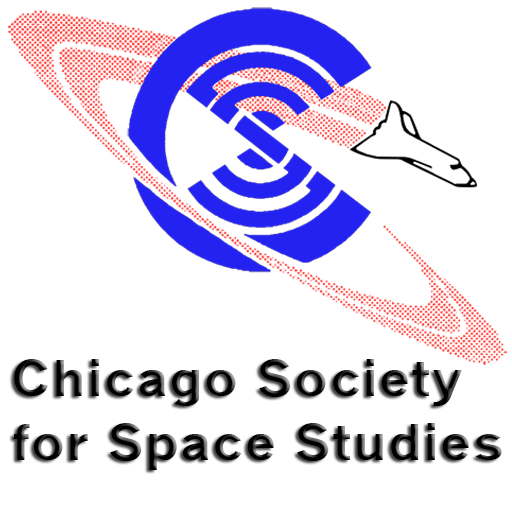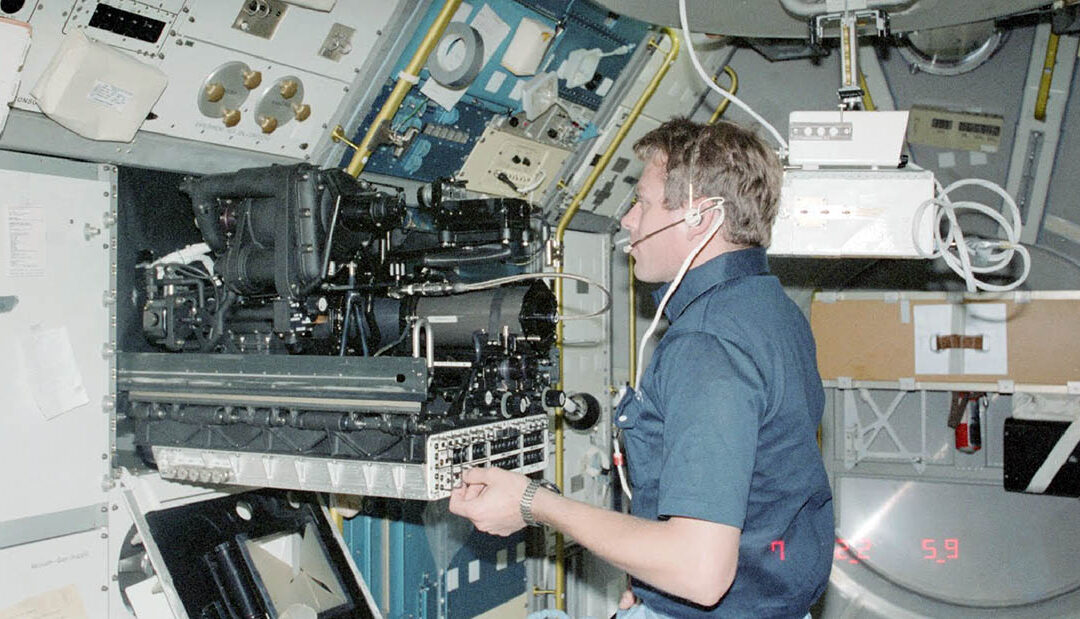Image: Payload Specialist Byron Lichtenberg working in the Spacelab on the Space Shuttle STS-009 mission in 1983
[This interview focused on Byron Lichtenberg’s involvement with the National Space Society and originally appeared in the February-March 1995 (v07n01) issue of Inside NSS under the title An NSS Director Profile of Byron Lichtenberg: Chapter Activist And Space Shuttle Payload Specialist]
For those who may be unfamiliar with Dr. Lichtenberg’s background, his education includes a Sc.B. in Aerospace Engineering from Brown University (cum laude 1969) and a S.M. in Mechanical Engineering (1975) and a Sc.D. in Biomedical Engineering (1979) both from the Massachusetts Institute of Technology. From 1969 to 1973, Dr. Lichtenberg served in the U.S. Air Force where he received two Distinguished Flying Crosses, 10 Air Medals, a Meritorious Service Medal, as well as other military medals. In 1983, Dr. Lichtenberg made his first trip into space on STS-9 as a Payload Specialist for the Spacelab 1 mission. His second flight was aboard STS-45 as a Payload Specialist for the ATLAS-1 Spacelab mission. In 1984, Dr. Lichtenberg, along with Anthony Arrott, founded Payload Systems, Inc. Payload Systems went on to obtain a license from the Dept. of Commerce in 1988 that allowed them to deal with Glavkosmos, the Russian Space Agency, to fly a protein crystal growth experiment aboard Mir. Dr. Lichtenberg is currently President and CEO of Omega Aerospace of Virginia Beach, VA, and he recently joined Southwest Airlines flying Boeing 737s
Jim Plaxco: How did you get involved with the National Space Society to begin with?
Byron Lichtenberg: Well, my involvement stems from all my years of working in the space program and realizing that it was very important to have a grass roots organization out there to try and promote the exploration and development of space for all people. I looked around for a while and there were a lot of different groups trying to do those kinds of things but the NSS is really the premier group. They have the largest membership and the most clout and it looked like the place to be. There were other folks like Charlie Walker who were supporting it, and I came to the conclusion that this was something that was important and worthwhile and an area where one could try to make a difference.
Plaxco: I know that you’ve done talks for different chapters. Could you talk briefly about your chapter involvement?
Lichtenberg: I am a member of the Langley NSS chapter down in southeastern Virginia and have been involved in that organization. Every year at Spaceweek they put on an annual picnic and have a rocket launching contest. I’ve been out there I guess three years now doing talks and trying to help work with the local media to get more exposure. About a year ago I did a talk at the Virginia Air and Space Science Museum and at that point, under the auspices of the NSS Langley chapter, had my flight suit, the two-piece IVA (intravehicular activity suit) put on exhibit at the museum. I also did some talks here in Chicago at the Museum of Science and Industry [Byron was the special guest of the Chicago area chapters at our 1993 Spaceweek event] and a series of talks that Jeff Liss had helped set up. And of course the NSS Headquarters things like the “Race for Space”, and I have participated in the ISDCs.
Plaxco: Do you have a particular vision for NSS or a direction you would like to see it go in and is it moving in what you see as the right direction?
Lichtenberg: I think we’re going in the right direction and I think we’re making progress. My vision is to see the NSS be the premier group that champions the opening of the space frontier for all folks and that really means lowering the cost of space access.
I think things like the SingleStage- to-Orbit and Reusable Technology conference that we hosted back in September in Washington – I think those are great things and I’m very excited about those kinds of activities because it brings together government, industry, and media; the people that you need to get together to try and make a difference. You know, after looking around at this for a couple of years, really the one thing that we can do to change things is somehow lower the cost of access to space and that is the premier goal that we need to address. My big thing is reusability, maintainability and operability so that you can take something up there and not throw it away every time. As to the particular design, that’s engineering tradeoffs: whether it’s single stage or two stage, whether it’s fly-back booster or winged vertical or horizontal takeoff or whatever. The particular solution, and I think that there is a family of solutions and not just one particular way to do it, the attributes that the systems have to have are reasonable development costs which says that you really need to use a lot of commercial off-the-shelf technology and equipment, which I think we can do now. You need to have a system that is robust and not on the very edge of performance margins.
Take something in the way that we do in the airlines: you take an engine and you certify it at a particular thrust rating; but then you normally operate it below that so that you are not up against the performance stops every time. Right now with the Shuttle we’re operating at 104 to 109 percent of rated power, so that gives you an idea of where the Shuttle is. What we need to do is get a system that is much more robust and drops back a notch in terms of performance.
Plaxco: Having been active in chapters, it seems that a lot of times there is conflict between the chapters and the NSS headquarters over things like direction or turf issues. How do you perceive your chapter’s relation with headquarters and what would you like to see done to try and resolve some of the friction that exists between some chapters and NSS headquarters?
Lichtenberg: In particular, it seems like the Langley chapter has had a really good rapport with headquarters so I haven’t really seen first hand a lot of the things that you talk about, but I know it’s out there. One of the things is it’s probably a good friction in many ways because there are some chapters that are very aggressive and want to go off and do all kinds of great things. Then there are other chapters that are more of a social club that gets together and talks about things.
The Langley chapter is somewhere in the middle. They’re focusing in on education. They’re building a model rocket that they’ve actually launched already and they’re looking for bigger places to launch it so they can go higher. They’re trying to get students involved, making it a community education thing as well as a way to make space exploration more visible and make the NSS more visible. So I think that they’re going about it the right way. I don’t want to dissuade the other chapters that are very aggressive because I think there is a place for that as well. It’s probably just the nature of the beast: when you have an organization of some 25,000 people and you try to figure out a direction, there are some people that want to go a little more left; there are some others who want to go a little more right; and others want to go a little bit up or down. It’s not all bad. I think the big thing that we all need to be aware of is that we are all in this together. We need to pull together and the only way that these things are really going to happen is by a concerted effort.
Plaxco: What to you think has been your greatest single accomplishment or achievement on behalf of the National Space Society?
Lichtenberg: Well, let me go back and add a piece to the chapters thing. There are actually two chapters in the Virginia Beach-Tidewater area. The other is the Dismal Swamp chapter and I’ve worked with them a little bit. They’ve helped support a program called Project Salute which is a several week summer school kind of activity for middle school grades and high school kids to get them involved and interested in space exploration. I’ve been down there several summers working with them, doing talks for the students and getting feedback from them. They’ve taken a school bus and outfitted it as a space shuttle and it’s really neat. So there are lots of things going on in education, trying to get the younger students really enthused and turned on to the whole thing. So, going back to your question about the greatest single thing , I guess it’s probably using what little notoriety I’ve gained being a two-time Space Shuttle flyer to try and bring more credibility to the organization; to try and help to give it some more visibility especially with the local chapters, because it’s a lot easier to get media, TV, and local radio out to cover an event if there is somebody there like an astronaut. It tends to bring those folks out a little more. So that is probably the greatest single thing: using the good fortune that I’ve had to fly in space twice and try to use that leverage to get more media attention.
Plaxco: Thanks Byron.
About the Author: Jim Plaxco is President of the Chicago Society for Space Studies and serves as the National Space Society’s Space Ambassador Program Subject Matter Expert for Economics.

